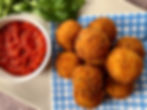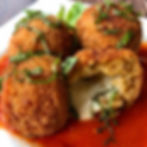"Crabancini"
- Bute St Seafoodie
- May 5, 2021
- 6 min read
Updated: Dec 12, 2021
"The climate’s delicate; the air most sweet.
Fertile the isle, the temple much surpassing
The common praise it bears.”
William Shakespeare (1623)
I was inspired to develop this dish of by an Instagram post from @charlie_eats_pasta. It's true that since then I have found a number of recipes online for "crab arancini", but I was after something specific in mind and it was that post that got me thinking.
As I've mentioned in previous posts, the brown meat from a crab is, to an unfortunate extent, a waste product. You only need to look at the range of crab products available in fishmongers and supermarkets to form a sense of the significant preference of the white meat by a great majority of the "crabsumer". And so I've made it an ongoing mission to find interesting ways to make use of the delicious and extremely economically-priced brown meat. I believe this is one.
The main departure I have taken from crab arancini recipes I have come across is to use exclusively the brown meat of the crab. I am more than satisfied that this works because the mozzarella, typically included in arancini, works as a calm, creamy softener to the rich, intense flavour of the brown crab meat. Another optional touch I've added is a pinch or two of ground mace or grated nutmeg which I find lends a sense of the "potted" seafoods (shrimps, for example) so traditional in the UK. I checked with my Italian foodie friend, the bellissima Manu, and it turns out that nutmeg at least is used in Italian households in much the same way as it is in UK ones, i.e. it may be added to Béchamel sauces and green leafy veg (like spinach), so I was comfortable I wasn't taking a step too far. Mace and nutmeg are, in the end, two products from the same fruit.
Now, in Sicily from where they originated (and Manu's Sicilian foodie friend Salvo helped me out here), arancini are traditionally encountered as street food, i.e. finger-food. They wouldn't typically be accompanied by a dipping sauce even if a tomato-based dipping sauce is something that might appear in modern-day incarnations. However, I think there are two very satisfying ways to serve these crabancini. The first is as a canapé, more in the style of their street-food origin, with at most two bites required to see each ball off. In this case I prefer to grate the mozzarella into the risotto so that the balls can be formed smaller, and, if liked, be served with a tomato dipping sauce. The second is to serve them larger, to be eaten with a knife and fork, with a knob of mozzarella oozing inside its surrounding of risotto (see the second image below), and these would make a great "primi", starter or fish course, served on a "gravy" of smooth tomato sauce.
Either way, I'm confident these are a super way of enjoying brown crab meat, tomato sauce or not. Buon appetito!

At the heart of this recipe are adaptations of three of Angela Hartnett's from her book "Cucina", definitely one of my go-to resources when working with traditional Italian cuisine. Arancini may certainly be considered as an excellent way to use up leftover risotto (or a reason to make more risotto than you actually need) and serious crab-lovers may really enjoy what is here an intensely crabby risotto made, as it is, just from the brown crab meat and in significantly greater proportions than any other crab risotto recipe I've seen. That said, because of the intensity of flavour I'm suggesting to dilute the stock to half-strength and, as mentioned above, once the mozzarella is within the mix, the intensity is naturally calmed, but extra seasoning is likely to be required.

So, although the recipe may look rather involved, it's actually quite straightforward but does take a bit of time. The best way to think of it is as three separate stages, corresponding to the three recipes of Angela Hartnett's. These are:
Make a basic risotto
Turn this into a crab risotto
Make crabancini
Thinking of it this way makes is clear that by stage 2 there is a crab risotto that can be enjoyed in its own right! Just stir in a bit of freshly shredded basil and/or some chopped parsley and that's a meal in itself for 2. You could even add a bit of white crab meat at the end for a really crabby number. Alternatively make the crab risotto up to a day ahead if preferred but, in any case, whenever stage 3 has been completed there will be sufficient crabancini for 4-5 easily.
Manu and I agree that the secrets to making a good risotto are good rice, good stock and good (read plenty) stirring! Hartnett's main tip is to keep the stock hot while adding only adding a ladleful of it at a time. A final tip, if making the larger mozzarella-centred crabancini is to give the finished balls a blast in a microwave for about 15 seconds to ensure an oozing centre. With that on board, what could possibly go wrong!?
"Crabancini"
Ingredients (Makes about 20 small balls or about 15 large balls - see recipe intro)
350-400ml vegetable stock mixed with an equal quantity of water (total 700-800ml)
150g brown crab meat
Juice of ¼-½ lemon
Tabasco, a few drops, to taste
1 tbsp olive oil
50g butter, cut into 10 cubes and kept in the fridge
1 small shallot, finely chopped (approx 25g once chopped, onion can be substituted)
175g risotto rice (Arborio, for example)
100ml white wine
Ground mace, 2 or 3 pinches (or use grated nutmeg)
Salt and freshly ground black pepper
Small handful of basil leaves
Small handful of flat leaf parsley leaves
90g buffalo mozzarella, drained
Plain flour, for dusting
2 eggs, beaten
Panko breadcrumbs, for coating
Sunflower or vegetable oil, for deep-frying
Freshly shredded basil and/or roughly chopped parsley leaves, to garnish (optional)
Basic tomato sauce (see note), to serve (optional)
Method
Put the stock in a saucepan, bring to the boil and keep at a gentle simmer while making the base risotto. Blitz the brown crab meat with the juice of ¼ lemon and the Tabasco in a blender.
Heat the oil and 3 cubes of the butter in a large sauté pan and, when hot, sweat the shallot (or onion) over a medium heat for a couple of minutes. Add the rice and cook, stirring for a further 2 mins. Increase the heat then pour in the wine and boil until it has largely evaporated. Now add a first ladleful of the stock and lower the heat to medium. Stirring regularly, if not continually, allow each batch of stock to be absorbed before adding the next so that a creamy, rather than watery consistency is achieved. The entire quantity of stock may not be required, or if more liquid is required, simply add boiling water. The whole process of adding liquid and stirring it in should take approximately 18 mins.
When this basic risotto is ready, stir in the blitzed brown crab meat and the ground mace (or grated nutmeg). Season well with salt, pepper and any additional lemon juice to taste then tip the crab risotto out onto a large plate to cool and fridge if making the crabancini at a later time.
When ready to cook the crabancini, put the cooled crab risotto in a mixing bowl. Finely shred the basil leaves and chop the parsley leaves and stir these into the risotto. Test and adjust the seasoning - it is worth slightly over-seasoning at this stage because the mozarella to be added will temper it.
If making large crabancini, go to step 7. For small crabancini, simply grate the mozarella into the risotto and fold it in. Roll the crabancini into balls about 1" in diameter and go to step 8.
For large, stuffed crabancini, cut the mozarella into 2cm cubes then surround these cubes with the risotto and roll into balls which will be about 1½-2" in diameter.
Put the flour, beaten egg and breadcrumbs in separate dishes. Put sufficient oil for deep-frying in a saucepan and heat to 180°C. In batches, roll the crabancini in the flour, dust off the excess, then roll in the beaten egg and let the excess drain off. Finally coat with the breadcrumbs. Deep fry each batch of crabancini until golden brown and, when ready, remove with a slotted spoon to a plate lined with kitchen paper. Keep warm in a low oven until all the crabancini have been through the same process.
Serve immediately, garnished with the freshly shredded basil and/or chopped parsley, if liked. The basic tomato sauce may be served as a dip for the smaller canapé-sized balls, or alternatively can be blitzed in a blender and served as a base of "gravy" for the larger crabancini.
Note
Basic tomato sauce: Sweat 1 chopped garlic clove in 1 tbsp extra virgin olive oil for about 1 min then add 1 tbsp tomato purée and cook for a further minute. Tip in 200g tinned chopped tomatoes, add a sprig or two of basil, bring to the boil and simmer gently for around 15 mins until the tomatoes have reduced and become pulpy. Remove the basil sprigs and taste for seasoning. This can be adjusted with salt, freshly ground black pepper, sugar and/or balsamic vinegar. Any extra sauce can be enjoyed in a simple pasta dish.
References
"Cucina", Angela Hartnett (2007), pp. 92, 97 and 228: https://www.amazon.co.uk/Angela-Hartnetts-Cucina-Generations-Italian/dp/0091910277
Links
charlieeatspasta, Instagram page, accessed 5 May 2021



